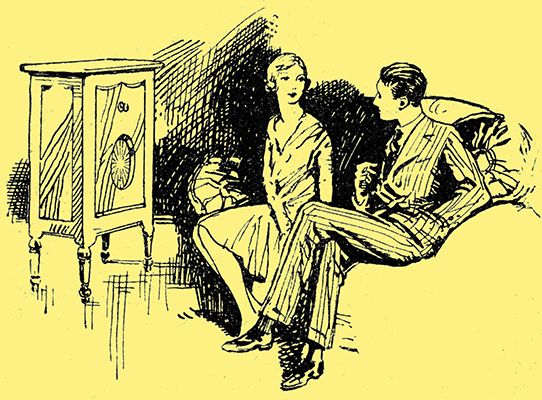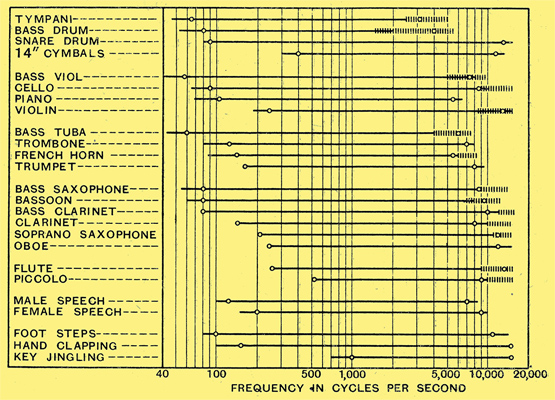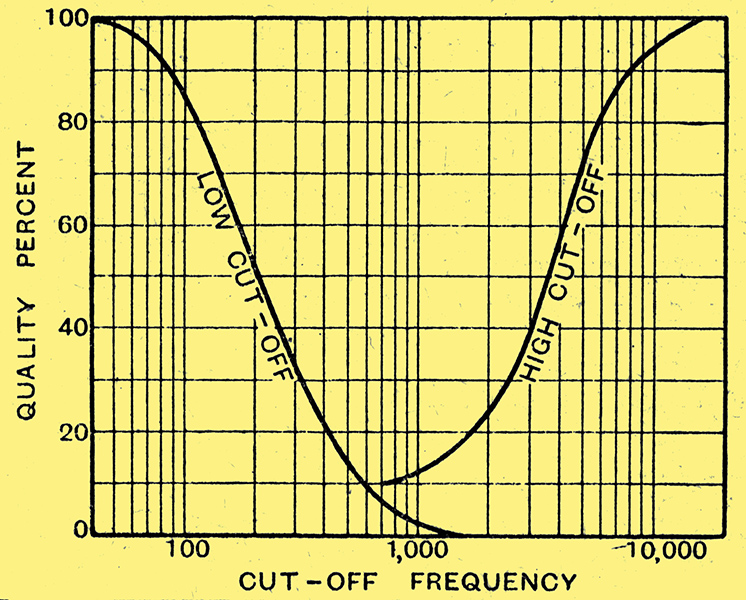|
Much public interest has been centred for some time past in the general question of quality of reproduction in relation to frequency range. A precise definition of quality seems almost unattainable, but in this authoritative article some important investigations which have been carried out in this direction are detailed and discussed.

A great deal has recently appeared in these columns on the subject of the upper audio limit which is practicable or desirable to reproduce in our present-day broadcast conditions. An undoubtedly original view apparently a unique one emanated from a correspondent who suggested: 'Should not a radio receiver be regarded purely and simply as a musical instrument operated on by artists at the studio, using the ether as a medium?' This idea has been so vigorously attacked by subsequent correspondents that no further ad hoc comment seems necessary. The prevailing view - and we cannot but feel that it is the correct one - is to regard wireless as a means of conveyance and reproduction, whose duty it is to reproduce with the utmost fidelity whatever its microphone hears.
Heard melodies are sweet, but those unheard are sweeter. - Keats, 'Ode on a Grecian Urn'.
Certain frequencies are present in the sounds that we are normally accustomed to hear. Some of these sounds have existed since the beginning of time, since indeed primitive man or his still more primitive prototype developed the auditory sense. Unfortunately, we have no record of the spectrum of frequencies comprised in the roar of the brontosaurus - that is, if it did roar.
Two recent articles by Mr H A Hartley have given a brief but lucid account of the physics of reproduction and hearing. In particular, there was given a chart showing the fundamental and harmonic frequencies involved in the various instruments, with contour lines of accurate reproduction for the various sources with different cut-off, e.g., at 5, 9, and 12 kHz. Without desiring in the least to retrace the ground covered by Mr Hartley, it may be of interest to review some recent experiments performed at the Bell Laboratories with the object of determining the frequency-ranges required for the most recognisably faithful reproduction of speech, music. and certain noises. The experiments were entirely empirical in character, jointly qualitative and quantitative, but represent perhaps the most exhaustive tests that have ever been made on the subject. In particular, the tests consisted of cutting off at various frequencies at the top and bottom of the audible range, and in estimating the effect of the cut-off.
How Tests Were Conducted
In the experiments, sounds were made before a special microphone in a sound-proof room and transmitted electrically to a loud speaker in another soundproof room. Between microphone and reproducer was inserted a control-room, where the level of reproduction could be varied at will, and where filters could be introduced also to cut off at various frequencies. Thus, starting at the bottom, a definite lower cut-off could be introduced at various points between 30 and 1,500 Hz, in twelve steps, while at the ascending end an upper cut-off could be introduced at various points between 750 and 13,000 Hz, in fourteen steps.
The sound-sources available included individual instruments up to a whole orchestra, male and female voices, general noises such as footsteps, hand-clapping, key-jingling, etc. The air-to-air transmission system had remarkably flat characteristics from 30 to 13 kHz, in the absence of filters. Companies of nine to fourteen people, all experienced in articulation and similar testing, formed the audience in the sound-proof receiving room. Indicating lamps below the loud speaker showed when a change had been made in the control-room, i.e., when any filter or filters were thrown in or out of circuit, without the observers knowing what the nature of the change-had been. The observers listened to two conditions, one filtered and one unfiltered, and judged, by aural estimation only which condition was filtered. If the observer obtained a score of 100% of correct judgments in a large number of trials the filter was considered to be absolutely detectable in its effect. A score of 50% was considered as indicating an undetectable filter, because the observer, if guessing, guessed rightly and wrongly an equal number of times. There were never less than nine observers, and each had at least six trials on each filter, so that the minimum number of observations used in computing the percentage of correct judgments on any filtering effect was fifty-four.
Results of Observations
It was found that the filter cut-off switch just produced detectable aural effects were not sharply defined. With most instruments it was noticed that the actual musical sounds were accompanied by other sounds, such as key-clicks, lip-noises, buzzing of reeds, and hissing of air, The observers tried to distinguish between the frequency-ranges carrying the two classes of sound.
The general observations are summarised below:
- Drums - Bass-drum and tympani had no important frequencies below 60 to 70 Hz; the tone range extended up to 1,000 to 2,000 Hz, with drum rattle and beating noise up to 5 kHz.
- String Instruments - Double-bass, 'cello, and violin all required to have the lowest fundamentals reproduced; tones rich in harmonics; bowing noise with the lower instruments.
- Piano - The lowest fundamentals were not important for the first octave, and a cut-off at 100 Hz was hardly noticeable. The upper notes were relatively pure tones.
- Brass Instruments - The lowest fundamentals were unimportant in the trombone and the French horn, but important in the trumpet and the tuba; the middle register was generally richest in harmonics, the higher register giving purer tones.
- Reed Instruments - The lowest fundamentals were important in the oboe, bassoon, and all clarinets; the medium register was again richest in harmonics, and the higher register gave purer tones; but blowing and reed noises become generally more prominent at higher frequencies. With saxophones the lowest fundamentals were not very important with the bass instrument, but were important with the soprano; with considerable blowing, with key noise and reed noise.
- Piccolo and Flute - The lowest fundamentals were very important; the highest notes almost pure tones, but much blowing and mechanism noise.
- Footsteps - No important frequencies occurred below 100 Hz, but frequencies up to 10 or 12 kHz were required.
- Hand Clapping - No important frequencies below 150 Hz, but high frequencies were required, although fairly natural effect was obtained with a cut-off at 8.5 kHz
- Key Jingling - No important frequencies below 500 Hz, but the entire audible range was needed at the upper end; a cut-off at 8.5 kHz gave a very unnatural effect.

Fig. 1. - Frequency-range of various sources of sound. Heavy lines, actual tone-range. Short vertical lines, ranges containing associated noises. Small circles show cut-off frequencies detectable in 80% of tests.
The collected results are shown in the chart of Fig. 1. The heavy portions of each line indicate the ranges of frequency thought to convey the 'tone-quality' of the instruments, while the short, vertical lines define the ranges allocated to the associated noises already mentioned. In some cases noise and tone seemed inseparably associated. The small circles on each line indicate the frequency cut-off of the filter (top and bottom) which was detectable in 80% of the tests.

Fig. 2. - Estimated quality of orchestral music as a function of the cut-off frequency at top and bottom.
Further tests consisted in the reproduction of orchestral music in which the observers were required to rate the quality of 'filtered music' as a percentage of the unfiltered. In one case the orchestration was such that most of the instruments played most of the time. In another case many instruments had solo parts, so that the character of the music changed rapidly during the performance. The smoothed results of these observations are given in Fig. 2, showing the improvement in the estimation of quality as the range of frequencies extended below 100 Hz at the bottom and above 5 kHz at the top.
The most important conclusions from all the tests can be summed up as follows:
- The piano was alone in producing tones with inaudible fundamentals
- Although frequencies down to 40 Hz were produced by the instruments, reproduction to only 60 Hz was considered almost as satisfactory
- The highest audio frequencies were necessary for perfect reproduction of musical instruments, chiefly because of the noises accompanying the musical tones. An upper cut-off at 10 kHz had a slight effect upon the tone-quality of most instruments; but: cut-off at 5 Hz had an appreciable effect on all except the large drums.
- Orchestral music improved materially as the lower cut-off was extended to about 80 Hz and the top cut-off extended to 8 kHz, but reproduction of the full audible range was preferred to any limitation of band width.
- Noises required the highest audible frequencies. A cut-off at 10 kHz caused appreciable reduction of naturalness in common noises, although it was felt that this cut-off would never preclude the recognition of the noise.
Since the appearance of Mr Hartley's articles criticism has been offered by correspondents as to the necessity for including such extremely high frequencies as 20 kHz. The detailed frequency-spectrum of various sound sources is still somewhat incomplete, and Mr Hartley's chart represents perhaps the most comprehensive spectrum of which we are aware. At the same time, the Bell Laboratories experiments certainly suggest that the increased purity of tone that occurs in the higher register of practically all instruments does not call for reproduction in excess of 10 kHz. The last conclusion quoted above would indicate that a like cut-off would be a perfectly practicable limit for most noises.
The Limitations Imposed by 5 kHz
In this connection it is interesting to note that it is now some four or five years since the Comite Consultatif International (Telephony) drew up a schedule which gave 30 to 10 kHz as representing a range covering practically perfect reproduction of speech, music, and most noises. This is substantially corroborated by the Bell Laboratories experiments. In any case, whether the upper limit be 10 kHz or higher, restriction to 5 kHz - compulsory or optional - is definitely condemned by available data.
The inevitable inference is that such limitation is depriving the broadcast listener of the quality that is otherwise within technical achievement. Wireless has certainly greater potentialities than either the gramophone or the talking film in the matter of reproduction. Apart from the loud speaker - which still remains the least specified link in the chain - wireless circuits can be arranged to cover an audio band limited only by adjacent-channel heterodyne interference. The method of tone-correction, put forward in the 'Stenode', and recently introduced in the 'Autotone' and the 'Monodial Super', is a valuable contribution to any limitations in the radio-frequency circuits, and permits us to take fuller advantage, of the best audio-frequency systems available.
On the other hand, gramophone recording is known to suffer definite limitations at both top and bottom of the audio range. With talkies the lowest frequencies are easily recorded, but the recording of the highest frequencies - above, say, 5 or 6 kHz - is difficult at practicable film-speeds, such as are set by other considerations, including, for example, the number of pictures per second. The purely - film-gramophone - that is, sound record on photographic film, not accompanied by cinema pictures suffers no such limitation, but is costly compared with the wax record, and is ruled out on this account.
In conclusion, it may not be out of place to review the subject from the viewpoint of the transmitting authority. This, fortunately, was recently given us in a well-reasoned contribution by Mr Noel Ashbridge to a recent IEE discussion on selectivity. This matter, in his view, was bound up with the broadcast transmitter. Listeners in Britain could be divided into two rough classes:
- those who receive a really strong signal, up to 20 mV/m or so, and
- those who receive less than 5 mV/m
a value becoming comparable with that received from many foreign stations, which are therefore liable to interfere. It had been suggested, he said, that the BBC should cut off at the transmitter the sidebands corresponding to the higher audio frequencies, but this would be objectionable in the quality supplied to listeners in the first of these classes. It was, indeed, noticeable to many people that the modulated output from 5XX was down at 5 kHz from the carrier. His conclusion was certainly to the effect that there was a need for the higher audio frequencies, and therefore for wider wavelength separation to permit it. Put into the Words of Shakespeare, we may say:
Damned be him that first cries hold, enough! - Macbeth, Act V, Sc. 7.
Let us hope that the BBC is successful in establishing this principle at the Madrid Conference to be held in the coming autumn.
|